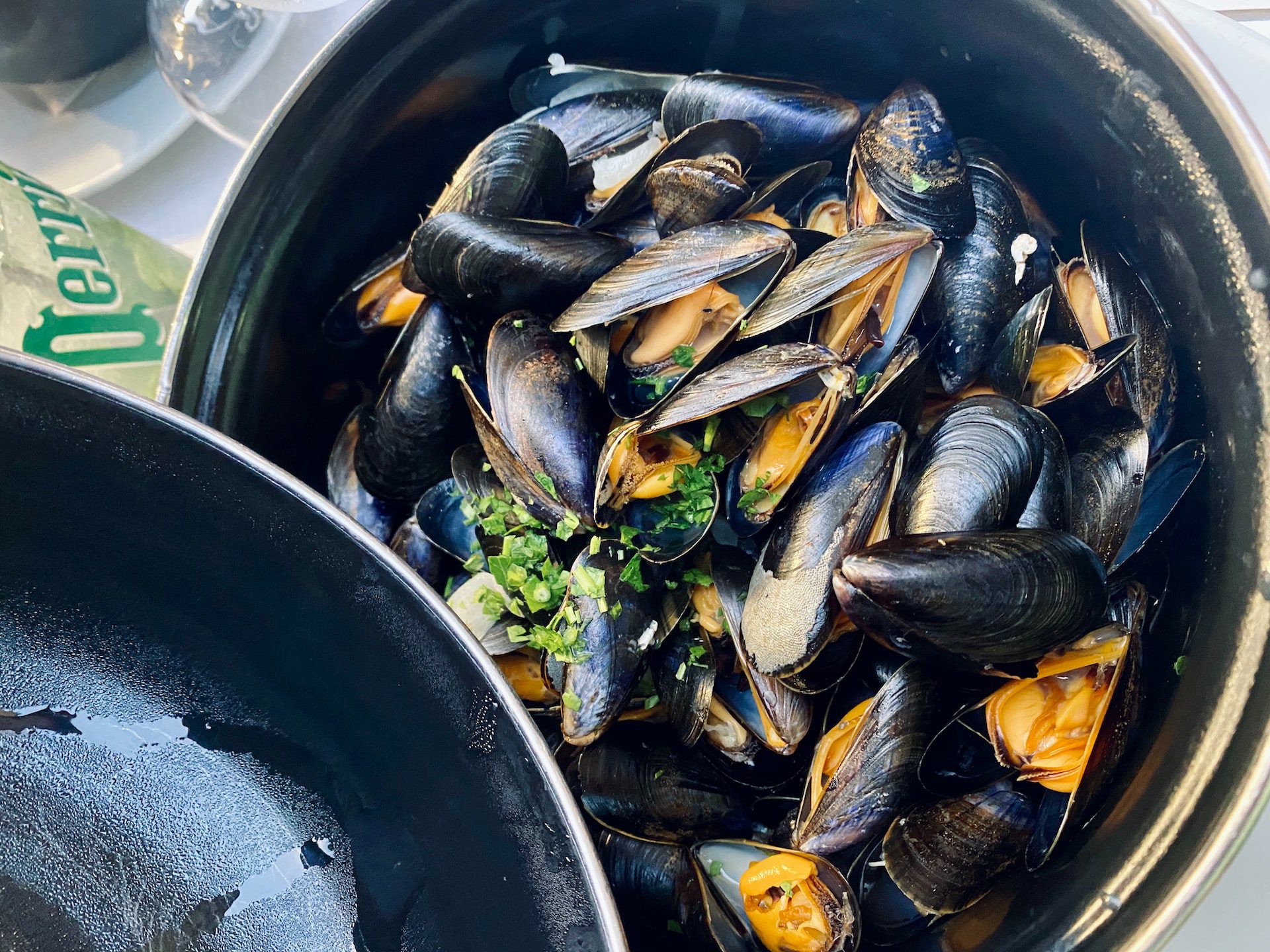
Maine mussels, specifically blue mussels, Mytilus edulis, are popular seafood found in the intertidal and shallow subtidal zones to depths of up to several hundred feet. They are a common bivalve mollusk that is harvested commercially throughout the year. However, taste does vary by season. The meat is at its best and has its greatest market value during the winter months up through the start of the spring and summer spawning cycle.
Reasons to Choose Maine Mussels
The frigid, pristine waters of the Gulf of Maine produce some of the best-tasting mussels in the world. Maine mussels thrive in the ever-changing tidal currents, which provide an abundant source of phytoplankton and other microscopic nutrients to feed on, rendering the meat plump and tender, with a softer texture than clams. The result, when cooked, is a distinctive, full-flavored, rich, yet sweet taste akin to a blend of oysters and clams.
Mussels are Sustainable
In Maine, blue mussels are sustainably harvested in the wild or raised on aquatic farms. The environmental cost and impact of farmed or wild mussels are minimal. As significant filter feeders, mussels help clean the waters they grow. Whether wild or farmed, mussels require no special diet. Their feeding activities filter and clean the water and produce a high-quality protein and exceptionally nutritious food source.
The growth rate of Maine mussels largely relates to circumstances within their immediate habitat, such as the amount of food or exposure to air. Perhaps the biggest difference between wild harvested and farmed mussels is the time it takes for them to grow. The normal lifespan of mussels is about 12 years, and it can take wild mussels from 7 to 12 years to obtain an ideal length of 2.5 inches. Farmed mussels take 18 to 24 months to reach a marketable size of 2.5 inches.
Most of the mussel landings in Maine are harvested from wild mussel beds located between Casco Bay and Jonesport. Aquaculture harvest occurs via two techniques: suspended culture and bottom culture. Of the two, the primary method is to grow the mussels vertically or horizontally on ropes attached to designed buoys or rafts typically placed near the water’s surface. However, a less labor-intensive method of farming is bottom culture. In this process, seed mussels are gathered from wild mussel beds and spread over a managed leased site dragged and thinned of predators to allow the mussels to increase their growth rate.
Nutritional Benefits
Mussels are a nutritionally rich food source that offers many health benefits. The tasty mollusks are low in fat and high in protein, containing all the essential amino acids for a healthy diet. Three ounces of mussels provide 40% of the daily protein the average person requires. They are also a moderately-high dietary source of omega-3 essential fatty acids, providing almost one gram omega-3 per 100-gram serving. Mussels contain many vitamins and minerals, too. They are good for vitamin B12, phosphorus, manganese, and selenium sources. It also provides a rare animal-based source of vitamin C and a good source of riboflavin (B2), thiamin (B1), niacin (B3), folate, iron, potassium, and zinc.
How to Cook Maine Mussels
There are many ways to prepare Maine mussels, such as roasting or grilling, but the easiest and most popular method is to steam them. Whichever way they are prepared, mussels must be rinsed in cool water and scrubbed of any grit. Fresh mussels are closed or will close if tapped on the shell and carry the briny scent of the sea. If the mussels are open, the shell is cracked, or even smell “fishy,” they should be tossed.
- Once cleaned, mussels can be steamed in salty water or, some recipes call for white wine, craft beer, or garlic and butter.
- Steaming means that too much liquid will boil and overcook them. The liquid should cover the bottom of the deep pan or stockpot to no more than a quarter of an inch. When steaming, the natural “juice” from the mussels will be released, forming a tasty broth with your liquid of choice. The specific length of steaming will vary depending on the number of mussels in the pot, their size, and the size of the cookware.
- To prepare, bring the liquid to a boil and add the shellfish. Cover them with a tight-fitting lid and steam for 5 to 10 minutes, depending on their size. Mussels are ready when the shells open. Those not open should be tossed.
Mussels are a well-rounded food source, full of nutrients, vitamins, and minerals. A shelled seafood delicacy, Maine mussels are among the best sustainable seafood choices. By maintaining water quality and serving as an indicator of the health of a waterbody, mussels also play an important role in the intertidal ecosystem.
Get Fresh Maine Seafood Delivered to Your Door
Don’t forget you can order FRESH live lobsters or fresh-picked meat online for delivery directly to your door! We also offer curbside pick-up at our South Portland location if you live locally – call for details and to place your order over the phone. Feel free to contact us— we would be happy to answer any of your questions.
